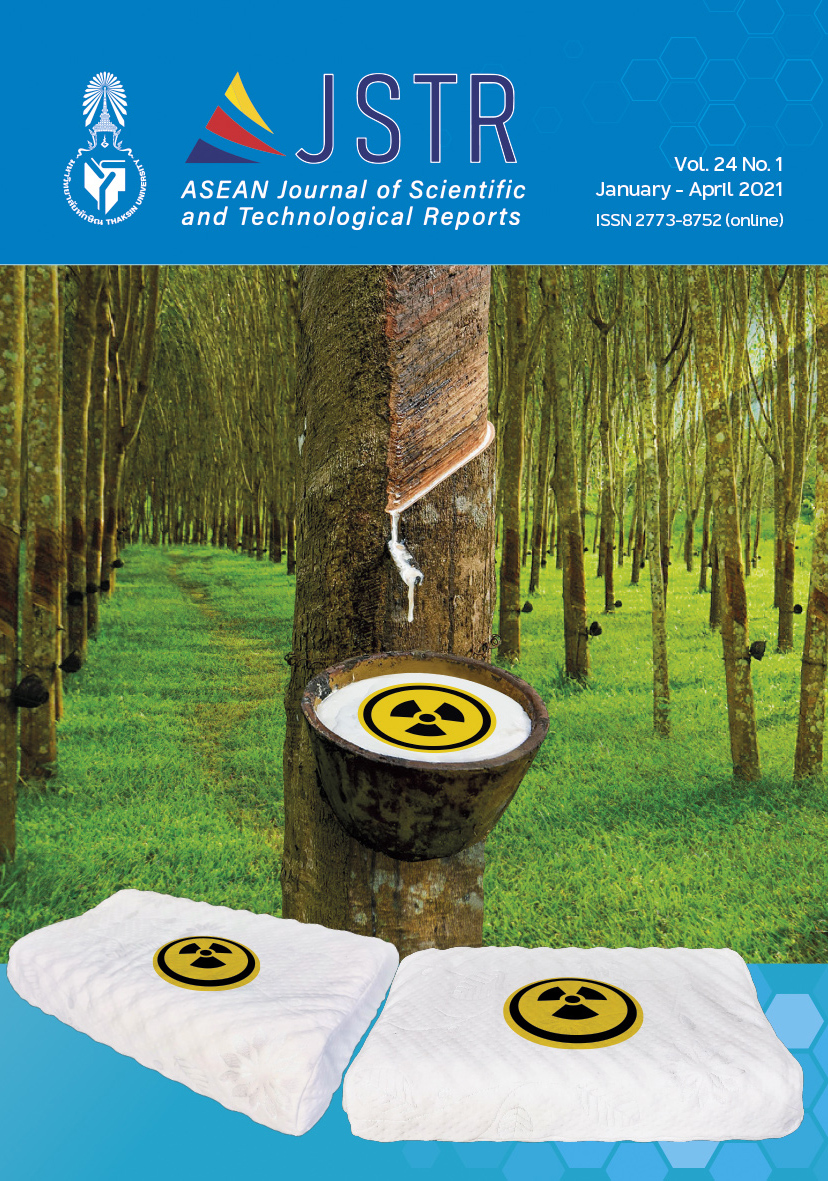The Production of Biodegradable Flowerpot from Sludge of Rubber Factory with Waste from Mushroom Culture and Palm Bunches
Main Article Content
Abstract
The concept for this research is that plants pots are produced from rubber plant sludge and waste material from the mushroom lump and palm bunch are use to replace products that are made from plastic, which is an alternative to reduce the amount of waste and add value to the waste material. The aims for this work are 1) to study the chemical characteristics of raw materials 2) to study the physical characteristics, and 3) to study properties of plant pots produced from rubber plant sludge, waste material from the mushroom lump and palm bunch. The conditions of experiment are 6 ratios between rubber plant sludge to waste material from the mushroom lump including 0 : 100, 20 : 80, 40 : 60, 60 : 40, 80 : 20 and 100 : 0. using wet glue and palm bunch as binder and subsidiary binder, respectively. The results revealed that 1) raw material has acid-base, conductivity, and moisture value suitable for growing plants, 2) the first ratio had the highest average weight of 246.67 grams and plant pot could be molded well, strong and have smooth skin, and 3) the first ratio has qualifications suitable for actual application; the water absorption was 99.18 percentages, an inflation value was 81.93 percentages and the slowest deterioration of the plant pot.
Article Details

This work is licensed under a Creative Commons Attribution-NonCommercial-NoDerivatives 4.0 International License.
References
Onman, P. (2018). Bioplastic innovation. Journal of Department of Science Service, 66(208), 10–11.
Vejchaprasit, T. (2013). Microbes and plastics. The Institute for the Promotion of Teaching Science and Technology Magazine (IPST Magazine), 41(182), 10–12.
Duangsri, C., & Raksajit, W. (2016). Polyhydroxyalkanoates: an alternative biomaterial for renewable plastic. Journal of Research Unit on Science, Technology and Environment for Learning, 7(2), 414–423.
Piyang, T., Chaichan, W., & Sagulsawasdipan, K. (2018). Environment-friendly plant pot production from palm oil sludge and mushroom cultured waste. Rajamangala University of Technology Srivijaya Research Journal, 10(3), 497–511.
Department of Agriculture. (2012). Bags of old mushroom spores are useful or harmful. Udon Thani agricultural news (Online). Retrieved 22 January 2020, from: http://www.wangsammo.Udonthani.doae.go.th/km%2001%2055.pdf.
The Association of Official Analytical Chemists (AOAC). (2000). Official methods of analysis. (17th Ed). AOAC International. Gaithersburg, MD, Maryland, USA.
Thai Industrial Standards Institute (TISI). (2005). Thai industrial standards for fertilizer, TIS. 75-2548B.E., Industrial Notification No. 3327 (Online). Retrieved 20 December 2019, from: http://www.fio.co.th/web/tisi_fio/fulltext/TIS75-2548.pdf.
Department of Land Development. (2010). Soil chemical inspection analysis process (Online). Retrieved 22 December 2019, from: http://www.ldd.go.th/pnpa/2553/manualosd-03.pdf.
Sanguansuk, P. (2009). Development of molded-pulp pot packaging from palm oil sludge and activated sludge cake for plant seedlings. Master’s Thesis. Kasetsart University.
Kaewchuea, P., & Kiatnukul, W. (2011). Project for the development of plant pots from sawdust, In The 8th National Kasetsart University Kamphaeng Saen Conference, December 8-9, 2011, Kasetsart University Kamphaeng Saen Campus, Nakhon Prathom: Kasetsart University.


